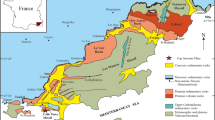Abstract
Ancient deposits of ferricrete (stratified iron oxyhydroxide or clastic sediment cemented by stratified iron oxyhydroxide) are present in headwater streams draining an historic mining district in the Rocky Mountains, USA. These deposits, which form under conditions of low pH and high metal concentrations, are present in streams draining many other mineralized areas. Radiocarbon dating of wood fragments entombed within the ferricrete indicates dates of deposition as old as 8840±50 years before present (b.p.). The ferricrete deposits provide evidence that natural, metal-rich acid rock drainage has been occurring in this mineralized region for thousands of years, due to the weathering and oxidation of exposed or near-surface massive sulfide ore deposits. The dating and chemical composition of the ferricrete deposits have applications to the environmental remediation of historic mining sites and to environmental issues related to natural background chemistry. In addition, the radiocarbon dates of the ferricrete deposits correlate closely with warm–wet periods in the Holocene record, showing that ferricrete deposits may represent a previously untapped source of paleoclimatic information.
Similar content being viewed by others
Author information
Authors and Affiliations
Additional information
Received: 6 October 1997 · Accepted: 23 March 1998
Rights and permissions
About this article
Cite this article
Furniss, G., Hinman, N., Doyle, G. et al. Radiocarbon-dated ferricrete provides a record of natural acid rock drainage and paleoclimatic changes. Environmental Geology 37, 102–106 (1999). https://doi.org/10.1007/s002540050366
Issue Date:
DOI: https://doi.org/10.1007/s002540050366




